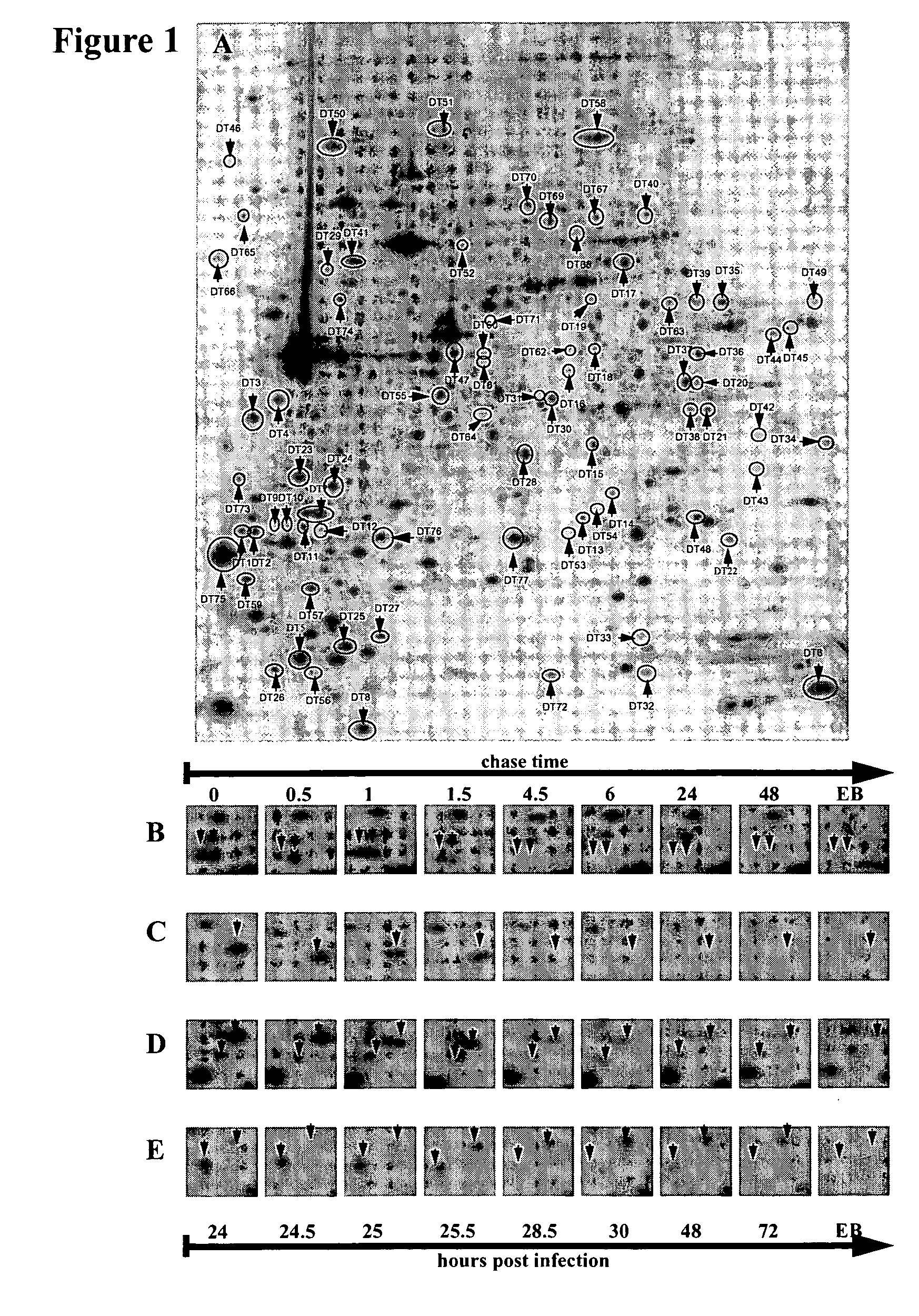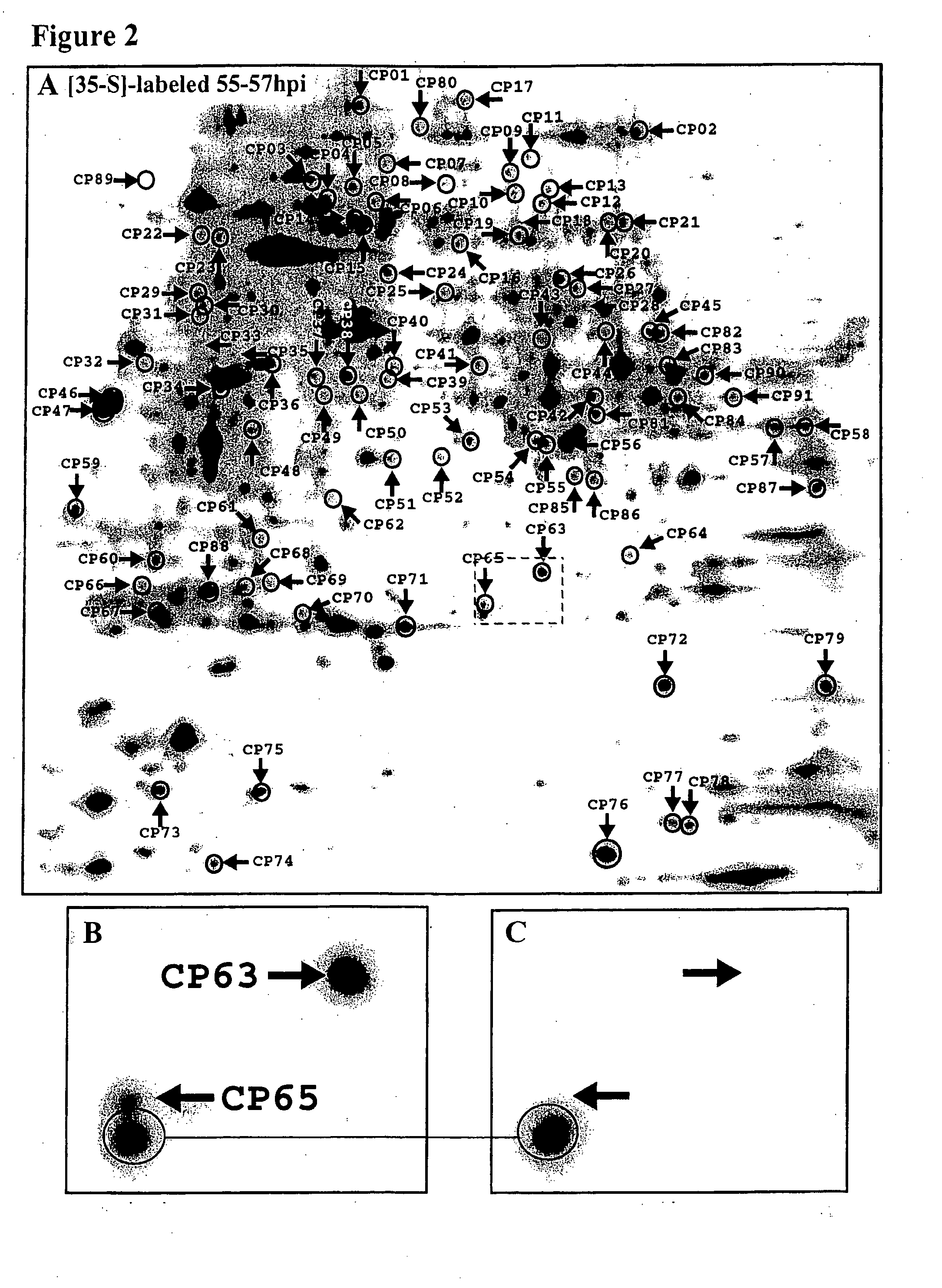Method for identification of proteins from intracellular bacteria
- Summary
- Abstract
- Description
- Claims
- Application Information
AI Technical Summary
Benefits of technology
Problems solved by technology
Method used
Image
Examples
example 1
Infection of Mammalian Cell Cultures
[0184] Semi-confluent HeLa, HEp-2 or McCoy (ATCC, Rockville, Md., USA) cell monolayers were infected with one inclusion forming unit (IFU) of C. pneumoniae VR1310, C. trachomatis serovar A (HAR-13), D (UW-3 / Cx) or L2.(434 / Bu)(ATCC) as previously described in [19.] and [17.] The infection medium consisted of RPMI 1640, 25 mM HEPES, 10% FCS. 1% w / v glutamine, 10 mg / ml gentamycin for C. trachomatis A and D and RPMI 1640, 25 mM HEPES, 5% FCS.1% w / v glutamine, 10 mg / ml gentamycin for C. trachomatis L2.
example 2
Pulse Labelling / Chase
[0185] To label chlamydial proteins for two hour periods, infected cell cultures were incubated in a medium containing RPMI 1640, 10 mg / ml gentamycin, 40 μg / ml cycloheximide, 100 μCi / ml [35S]-methionine / cysteine (Promix, Amersham Pharmacia Biotech, Uppsala, Sweden) as described previously (Shaw et al., 1999,2000) [18.] [19.]. After labelling the labelling medium was changed to normal growth medium following two washes in normal growth medium and the infected cells were harvested at different points in time after labelling. Similarly, labelled EB proteins were obtained by allowing the Chlamydia to grow until 72 h.p.i. after the two hour labelling periods. The labelled EB were then harvested and purified using two consecutive steps of density gradient ultracentrifugation essentially as described for C. trachomatis in (Schacter and Wyrick, 1994) [22.]and for C. pneumoniae (Knudsen et al. 1999 [17.]). Proteins in the EB preparation and pulse chase preparation were...
example 3
[0186] Following [35S]-labelling cells were washed twice in PBS and solubilised in a standard lysis buffer containing 9 M Urea, 4% w / v 3-[(3-cholamidopropyl)dimethylammonium]-1-propanesulfonate (CHAPS; Roche, Germany), 40 mM Tris Base, 65 mM DTE and Pharmalyte 3-10 (Amersham Pharmacia Biotech). For the enrichment of high molecular weight and hydrophobic proteins 7 M urea, 2 M thiourea, 4% w / v 3-[(3-cholamidopropyl)dimethylammonium]-1-propanesulfonate (CHAPS; Boehringer Mannheim, Germany), 40 mM Tris Base,65 mM dithioerythretiol (DTE) and 2% vol / vol Pharmalyte 3-10 (Amersham Pharmacia Biotech) was used essentially according to (Harder et al. 1999 [23.]). Samples containing whole cell lysates or purified EB were sonicated and centrifuged at 10 000×g for 10 min. Samples were stored at −70° until used.
PUM
| Property | Measurement | Unit |
|---|---|---|
| Fraction | aaaaa | aaaaa |
| Fraction | aaaaa | aaaaa |
| Fraction | aaaaa | aaaaa |
Abstract
Description
Claims
Application Information
 Login to View More
Login to View More - Generate Ideas
- Intellectual Property
- Life Sciences
- Materials
- Tech Scout
- Unparalleled Data Quality
- Higher Quality Content
- 60% Fewer Hallucinations
Browse by: Latest US Patents, China's latest patents, Technical Efficacy Thesaurus, Application Domain, Technology Topic, Popular Technical Reports.
© 2025 PatSnap. All rights reserved.Legal|Privacy policy|Modern Slavery Act Transparency Statement|Sitemap|About US| Contact US: help@patsnap.com



